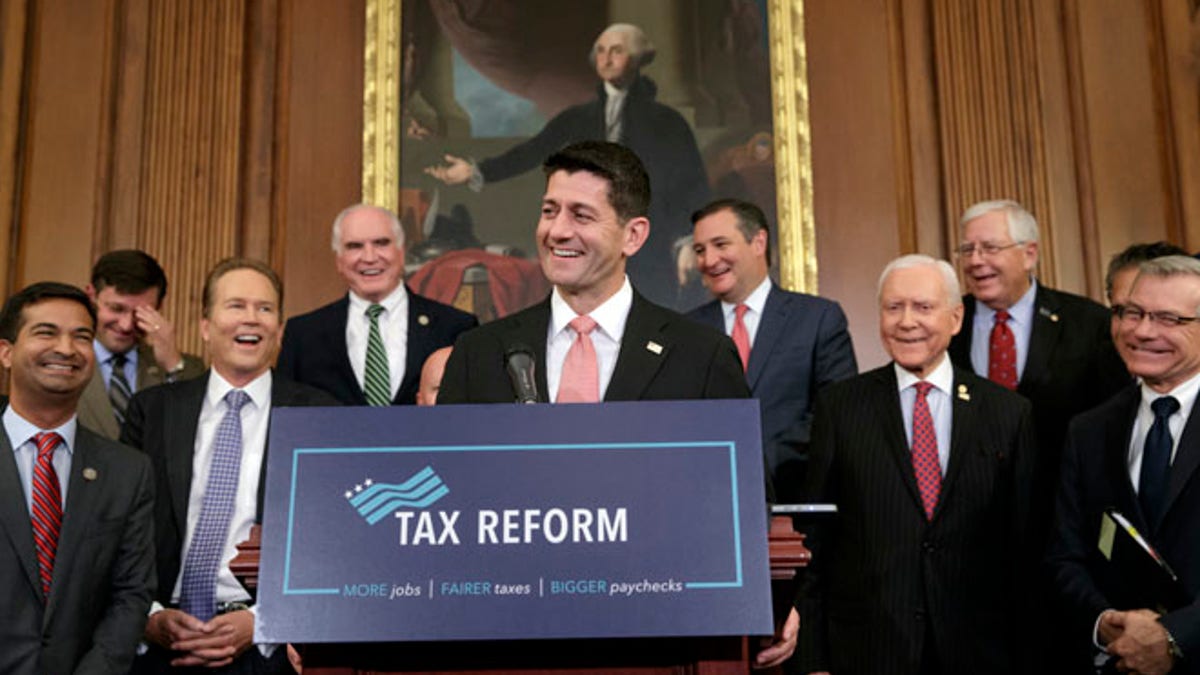President Trump: We want tax reform that is pro-America
President Trump says tax reform proposal will bring back jobs and wealth to the United States
President Trump promised drastic tax cuts Wednesday as he touted Republicans' newly unveiled tax reform plan, arguing the push to re-write the tax code would fuel “America’s economic comeback.”
“These tax cuts are significant,” the president said during a speech at the Farm Bureau Building in Indianapolis. “There’s never been tax cuts like we’re talking about.”
Republicans earlier Wednesday released the framework of their plan that was hammered out by House and Senate lawmakers in coordination with the Trump administration. Trump used his speech in Indiana, in part, to begin applying public pressure on lawmakers -- especially Democrats -- to get on board.
“Call your congressman. Call your senators,” Trump said. “Let them know you’re watching, let them know you’re waiting. Tell them that today is the day for decision. That now is the time to heal this self-inflicted economic wound.”
He added, “If you demand it, the politicians will listen.”
As part of his effort to woo the other side, Trump invited Indiana Democratic Sen. Joe Donnelly to fly with him on Air Force One. But the president also warned with a smile during the speech that if Donnelly doesn’t support the plan, “We will come here, we will campaign against him like you wouldn't believe."
READ THE GOP TAX PLAN FRAMEWORK
The plan would simplify the tax system, cut rates and nearly double the standard deduction used by most Americans. Trump pitched it as the biggest tax cut in U.S. history.
“Over the next few months, the House and Senate will build on this framework and produce legislation that will deliver more jobs, higher pay and lower taxes for middle-class families, for the working man and woman, and for businesses of all sizes,” the president said.
Getting any substantial Democratic support could be a heavy lift. Already, party leaders were panning the proposal, with House Minority Leader Nancy Pelosi, D-Calif., saying in a statement: "Republicans’ tax framework is not tax reform, it is a framework that gives away the store to the wealthiest, while sticking the middle class with the bill."
The stakes are high, after Republicans a day earlier scrapped their latest effort to repeal and replace ObamaCare.

Speaker of the House Paul Ryan, R-Wis., smiles as he talks about the Republicans' proposed rewrite of the tax code for individuals and corporations, at the Capitol in Washington, Wednesday, Sept. 27, 2017. President Donald Trump and congressional Republicans are writing a far-reaching, $5-trillion plan they say would simplify the tax system and nearly double the standard deduction used by most Americans. (AP Photo/J. Scott Applewhite) (AP)
During his speech, the president discussed the health care effort, claiming Republicans have the votes on the Graham-Cassidy health care legislation. But, in an apparent reference to Mississippi Republican Sen. Thad Cochran, Trump said one “yes vote” is home sick and unavailable to vote.
“We have a wonderful senator, a great, great senator, who is a yes vote,” Trump said. “But he’s home recovering from a pretty tough situation.”
Citing the Senate process called “budget reconciliation,” which gives Republicans until Friday to pass health care legislation without a filibuster threat, the president said they will wait a few months before being able to vote on it.
Now, the legislative focus shifts to tax reform, which Trump has been eager to tackle since taking office.
“The current tax system is a colossal barrier standing in the way of America’s economic comeback, because it can be far greater than it’s ever been,” Trump said.
REPUBLICANS UNVEIL TAX PLAN, CALL FOR DOUBLING DEDUCTION AND CUTTING RATES
The plan, as outlined in the framework, nearly doubles the standard deduction to $12,000 for individuals and $24,000 for families. This basically increases the amount of personal income that is tax-free.
Congressional Republicans describe this as creating a larger “zero tax bracket.”
The plan also collapses the number of personal tax brackets from seven to three. By simplifying the system, most Americans would be able to file their taxes on a postcard, the plan says.
The individual tax rates would be 12 percent, 25 percent and 35 percent -- and the plan recommends a surcharge for the very wealthy. But it does not set the income levels at which the rates would apply, so it's unclear just how much of a tax change there might be for a typical family.
Deductions for mortgage interest and charitable giving would remain, but the plan seeks to end most other itemized deductions that can reduce how much affluent families pay.
The plan would seek to help families by calling for an increased child tax credit and opening it to families with higher incomes. The credit currently is $1,000 per child. Also proposed is a new tax credit of $500 to help pay for the care of the elderly and the sick who are claimed as dependents by the taxpayer.
The estate tax -- which is paid by those with multimillion-inheritances -- would be eliminated, a boon for wealthy individuals who inherit businesses, investments and real estate.
Corporations, meanwhile, would see their top tax rate cut from 35 percent to 20 percent.
New benefits would be given to firms in which the profits double as the owners' personal income. They would pay at a 25 percent rate, down from 39.6 percent.
The Associated Press contributed to this report.

























